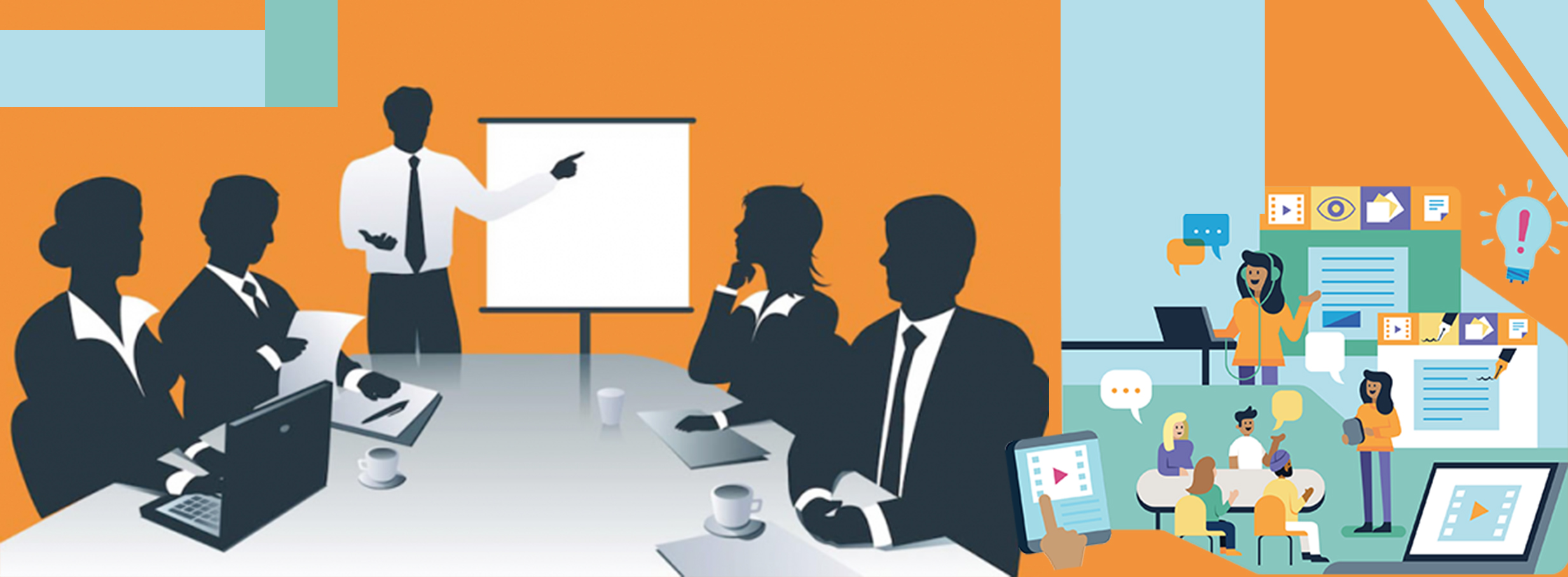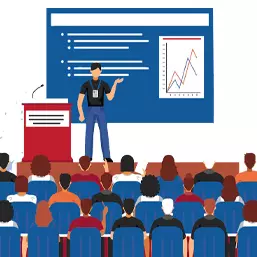
Conquering Stage Fright
If I ever completely lost my nervousness I would be frightened half to death.
– Paul Lynde
Introduction
Nearly everyone experiences some degree of stage fright when speaking before a group. And it’s not at all in your head either. When you face something threatening or challenging, your body reacts in what psychologists call the fight or flight response. This response provides your body with increased energy to deal with threatening situations. It also creates those sensations – dry mouth, sweaty hands, increased heartbeat, and stomach butterflies – all that we associate with stage fright. The fight or flight response arouses your body for action – in this case, speak and present.
Nervousness is normal when giving a presentation. After all, public speaking is the top fear in the top ten lists of fears. Nervousness can strike at different points in a presentation:
- At the beginning
- If you feel the audience has slipped away from you
- If your memory betrays you.
This lesson will provide you with concrete strategies for overcoming presentation jitters.
Brief check
Stage fright is both natural and controllable.
Preparing Mentally
Visualization is the formation of mental visual images. It is an excellent way to prepare your mind before a presentation. There are several types of visualization:
- Receptive Visualization: Relax, clear your mind, sketch a vague scene, ask a question, and wait for a response. You might imagine you are on the beach, hearing and smelling the sea. You might ask, “Why can’t I relax?”, and the answer may flow into your consciousness.

- Programmed Visualization: Create an image, giving it sight, taste, sound, and smell. Imagine a goal you want to reach or healing you wish to accelerate. Jane used visualization when she took up running, feeling the push of running the hills, the sweat, and the press to the finish line.
- Guided Visualization: Visualize again a scene in detail, but this time leaves out important elements. Wait for your subconscious to supply missing pieces to your puzzle. Your scene could be something pleasant from the past.
The process for Effective Visualization
- Loosen your clothing, sit or lie down in a quiet place, and close your eyes softly.
- Scan your body, seeking tension in specific muscles. Relax those muscles as much as you can.
- Form mental sense impressions. Involve all your senses; sight, hearing, smell, touch, and taste.
- Use affirmations. Repeat short, positive statements and avoid negatives such as “I am not tense”; rather, say “I am letting go of tension.”
- Use affirmations. Repeat short, positive statements that affirm your ability to relax now. Use present tense and positive language. As an example:
- Tension flows from my body
- I can relax at will.
- I am in harmony with life.
- Peace is within me.
Visualize three times a day. It’s easiest if you visualize in the morning and at night while lying in bed. Soon, you will be able to visualize just about anywhere, especially before a presentation.
Physical Relaxation Techniques
People who are nervous tend to breathe many short, shallow breaths in their upper chest. Breathing exercises can alleviate this. You can do most breathing exercises anywhere. Below are some exercises that will assist you in relaxing.
- Breathing Exercises: Deliberately controlling your breathing can help a person calm down. Ways to do this include: breathing through one’s nose and exhaling through one’s mouth, breathing from one’s diagram, and breathing rhythmically.
- Meditation: Meditation is a way of exercising mental discipline. Most meditation techniques involve increasing self-awareness, monitoring thoughts, and focusing. Meditation techniques include prayer, the repetition of a mantra, and relaxing movement or postures.
- Progressive Muscle Relaxation (PMR): PMR is a technique of stress management that involves mentally inducing your muscles to tense and relax. PMR usually focuses on areas of the body where tension is commonly felt, such as the head, shoulders, and chest area. It’s a way to exercise the power of the mind over the body.
- Visualization: Visualization is the use of mental imagery to induce relaxation. Some visualization exercise involves picturing a place of serenity and comfort, such as a beach or a garden. Other visualization exercises involve imagining the release of anger in a metaphorical form. An example of this latter kind of visualization is imagining one’s anger as a ball to be released to space.
Appearing Confident in Front of the Crowd
In addition to everything we’ve discussed, below are some tips for maintaining your confidence when you’re “on”.
- Get a good night’s sleep
- Practice your words along with your visuals
- Have a full “dress rehearsal”
- If you are traveling to a new site out of town, try to arrive early in the evening and locate the site. That way you won’t be frazzled in the morning, trying to locate the venue.
You can learn to control and reduce stage fright as well as to incorporate techniques for effective speaking by using the following strategies and techniques before, during and after your presentation.

Before Your Presentation
Prepare thoroughly: One of the most effective strategies for reducing stage fright is, knowing your subject thoroughly. Research your topic diligently and prepare a careful sentence outline. Those who try to “wing it” usually suffer the worst butterflies – and make the worst presentations.
Rehearse repeatedly: When you rehearse, practice your entire presentation, not just the first half or a part of it. Place your outline sentences on separate cards. You may also wish to include transitional sentences to help you move to the next topic. Use these cards as you practice, and include your visual aids in your rehearsal. Rehearse alone or before family and friends. You may also research using audio or videotape so that you can evaluate your effectiveness.
Time yourself: Most audiences tend to get restless during a longer presentation. Thus, try to complete your presentation in no more than 20 minutes. Set a time during your rehearsal to measure your speaking time.
Request a lectern: Every beginning speaker requires the security of a lectern or a high desk from which to deliver the presentation. It serves as a note holder and a convenient place to rest wandering arms and hands.
Check the room: Before you present, make sure that the lectern has been provided. If you are using sound equipment or a projector, be certain they are operational. Check electrical outlets and the position of the viewing screen. Ensure that the seating arrangement is appropriate to your needs.
Greet members of the audience: Try to make contact with at least a few members of the audience when you enter the room, while you are waiting to be introduced, or when you walk to the podium. Your body language should convey friendliness, confidence, and enjoyment.
Practice stress reduction: If you feel tension and fear while you are waiting your turn to present, use stress reduction techniques, such as deep breathing.
During Your Presentation
Begin with a pause: When you first approach the audience, take a moment to adjust your notes and make yourself comfortable. Establish your control of the situation.
Present your first sentence from memory: By memorising your opening, you can immediately establish as rapport with the audience through eye contact. You will also sound confident and knowledgeable.
Maintain eye contact: If the size of the audience overwhelms you, pick out two individuals on the right and two on the left. Talk directly to these people.
Control your voice and vocabulary: This means speaking in moderated tones but loudly enough to be heard. Eliminate verbal static, such as ah, er, you know and um. Silence is preferable to meaningless fillers when you are thinking of your next idea.
Put the breaks on: Many novice presenters speak too rapidly, displaying their nervousness and making it difficult for audience to understand their ideas. Slow down and listen to what you are saying.
Move naturally: You can use the lectern to hold your notes so that you are free to move about casually and naturally. Avoid fidgeting with your notes, your clothing or items in your pockets. Learn to use your body to express a point.
Use visual aids effectively: Discuss and interpret each visual aid for the audience. Move aside as you describe it so that it can be seen fully. Use a pointer if necessary.
Avoid digressions: Stick your outline and notes. Don’t suddenly include clever little anecdotes or digressions that occur to you on the spot. If it’s not part of your rehearsal material, leave it out so that you can finish on time. Remember, too, that your audience may not be as enthralled with your topic as you are.
Summarise your main points: Conclude your presentation by reiterating your main points or by emphasising what you want the audience to think or do. Once your have announced your conclusion, proceed to it directly.
Brief check
Through preparation, extensive rehearsal, and stress-reduction techniques the presenter can lesson stage fright.
After Your Presentation
Distribute hand-outs: If you have prepared hand-outs with data that your audience will need, pass them out when you have finished your presentation.
Repeat questions: Although the speaker may hear the question, audience members often do not. Begin each answer with a repetition of the question. This also gives you thinking time. Then, direct your answer to the entire audience.

Reinforce your main points: You can use your answers to restate your primary ideas. For example you might say, “ I’m glad you brought that up because it gives me a chance to elaborate on…” In answering questions, avoid becoming defensive or debating the questioner.
Keep control: Don’t allow one individual to take over. Keep the entire audience involved.
Avoid yes, but answers: The word but immediately cancels any preceding message. Try replacing it with and. For example, “Yes, X has been tried. And Y works even better because…”
End with a summary and appreciation: To signal the end of the session before you take the last question, say something like “We have time for just one more question”. As you answer the last question, try to work it into a summary of your main points. Then, express appreciation to the audience for the opportunity to talk with them.
Practical Application
Brian could feel his nerves starting to get the better of him the night before the presentation he was scheduled to give. He couldn’t figure out why he was feeling nervous. Brian had rehearsed his speech as well as his visuals in advance. He’d gone through the entire dress rehearsal process. His route to the training site had even been practiced the day before, when he’d gone to the site in the morning.
Brian recalled that he hadn’t yet tried deep breathing, which he regretted. He sat back in his easy chair, took a few deep breaths, and visualized the training session being a success in his mind. Following the session, he reported feeling refreshed and significantly calmer. Brian made the decision that he absolutely needed to get a good night’s sleep in order to be rested and ready for the day ahead.
Brian was still a little nervous the next day, even though it was the day after. Nonetheless, once he got started, the training went much more smoothly than he could have anticipated. He was even invited back the following month to participate in a follow-up training session.





